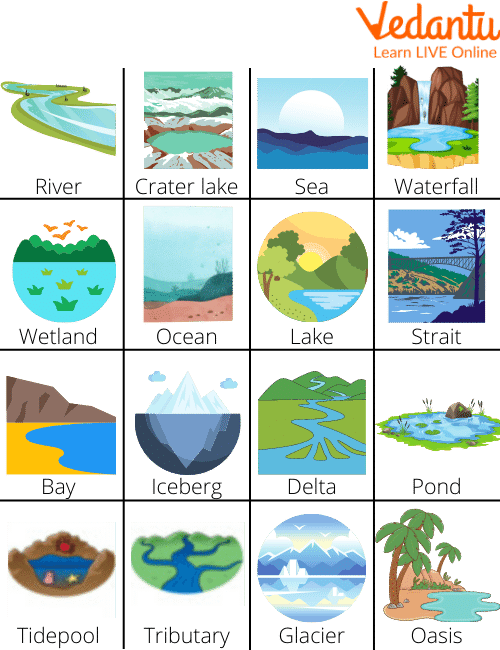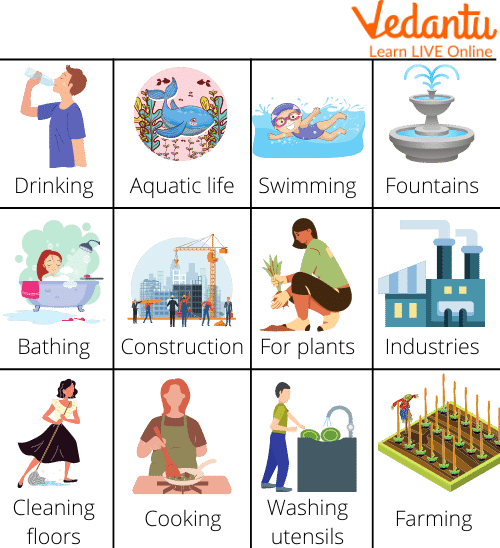




An Introduction to Water, Uses of Water and Sources of Water for Kids
Before we learn about where freshwater comes from, it’s important to know what it is. Freshwater is different from seawater and brackish water because it has very little salt. Brackish water has more salt than freshwater but less than seawater.
Freshwater comes from rivers, lakes, ponds, wetlands, glaciers, icebergs, ice caps, aquifers, and groundwater. These sources have very low salt levels, usually less than 500 parts per million (ppm).
Even though most of the Earth’s water—about 70%—is salty ocean water, there are many natural places where we can find fresh water. Freshwater is very important in our daily lives. It gives us drinking water and is used for cooking, cleaning, and growing crops.
Knowing the uses of water for kids helps them understand how water is part of their everyday lives. We use it to drink, bathe, brush our teeth, water plants, and wash clothes. Water also helps animals survive and keeps nature healthy.
By learning about where freshwater comes from and how we use it, kids can understand how important it is. Since only a small part of the Earth’s water is freshwater, it’s important to use it carefully.
Also Read Water - A Wonder Liquid
The Four Sources of Freshwater
The main sources of water are rain, groundwater, ice, rivers, lakes, streams, and natural reservoirs. We derive water for daily use through these sources. Let us now learn about each of these sources of water in detail.
Rain
An important source of freshwater that is often overlooked is stormwater. This is the product of earth's water that has evaporated into the atmosphere and turned into rain. Making the most of an unlimited supply of freshwater that is sometimes taken for granted, rainwater harvesting is a technology that was employed by ancient civilizations and is currently commonly used in many rural places.

A Girl Enjoying the Rain
Groundwater
Beneath the surface of the earth lies a great source of freshwater. Groundwater is the largest source of freshwater on the planet and the second largest source of water, along with that present in the oceans. Like the salt water of the sea, most of it cannot be consumed by people or animals. However, a percentage of the groundwater is fresh and can be desalinated and refined in order to provide safe drinking water for the population.
Ice
A major topic of debate surrounding the earth's climate change issues is the melting of the polar ice caps and the shrinking of ice shelves throughout the Arctic. Along with groundwater, ice makes up the second largest source of freshwater on the planet, accounting for just under 2 percent of earth's water. Some of the freshwater preserved in ice, especially in the Antarctic ice sheets, is thousands of years old. As with groundwater and seawater, it is also difficult to use ice water as a source of drinking water, but it is possible.
Rivers, Lakes, Streams, and Natural Springs
As the only natural source of freshwater on earth, rivers, lakes, streams, and natural springs are referred to as surface water sources (0.0014 per cent). Despite the fact that there are millions of freshwater lakes and many kilometres of rivers and streams on the planet, these water sources represent an almost insignificant amount of freshwater. However, they remain vitally important: A large amount of our drinking water comes from them.
You can see the main water sources images below:

Sources of Water
Uses of Water Chart for Kids
The importance of water for human beings is not only in its daily use such as washing dishes, personal hygiene, watering plants, etc. There are activities in which water plays a very important role and also becomes an economic and industrial resource. These various uses of water reflect its importance in the development and growth of the human being in all its areas. The below image shows the uses of water for kids to learn.

Uses of Water
Human consumption: Water is used for drinking, to make the different beverages that man consumes, to prepare food, and in factories where food is processed.
Personal hygiene: Personal hygiene activities are where water is most wasted: people tend to waste thousands of litres of water when bathing and brushing their teeth. Pisciculture: This is an activity that refers to the cultivation of fish, that is, their breeding and reproduction. In it are also shellfish and, in general, any aquatic animal.
Agriculture: The importance of water for this set of activities created by man is fundamental, it is where fruits, vegetables, and grains are grown for human consumption. The land is treated so that it is fertile and can provide food for people and animals.
Industry: There are different sectors in which the function of water is important. It can be from a technological point to the textile sector that is responsible for the creation of fabrics.
Summary
Although most of the earth is water (1,386 million km3 of water), only 2.5% of this water is freshwater. Of this percentage, only 0.01% is found in rivers and lakes and 0.5% in underground deposits. Of all this amount of water that the planet has, only 0.007% is drinking water and due to environmental pollution, reserves are reduced year after year. We hope you have learnt about the importance and uses of water in this article and will practise saving it rather than wasting it.
FAQs on Uses of Water for Kids - An Essential Element to Live
1. What are the properties of water for kids?
The world appears blue when viewed from space. Since water covers a large portion of the world, this blue colour is really water. Since we depend on water for practically everything—drinking, bathing, cooking, etc.—it is important that we understand some of its characteristics. The water content of the human body is 65 percent. The existence of life on earth depends on water. The earth's surface is unevenly covered in water. It dissolves practically all polar solutes and creates a significant solvent.
2. How can we save water?
Below stated are certain ways that can be used to save water:
Look for leaks in your toilet.
Shower for fewer minutes.
While you are brushing your teeth, turn off the water.
Check for leaks in the pipes and faucets.
When washing your car, avoid using the hose.
3. What are 10 uses of water for kids?
1. Drinking
2. Cooking
3. Bathing
4. Brushing Teeth
5. Washing Hands
6. Washing Clothes
7. Washing Dishes
8. Watering Plants
9. For Pets and Animals
10. Playing (like water games and swimming)
3. Why is water important for kids?
Water is essential for keeping kids healthy, helping with digestion, and keeping their bodies hydrated.
4. What are the main uses of water for kids?
Kids use water for drinking, bathing, brushing teeth, washing hands, playing, and watering plants.
5. How can kids save water at home?
Kids can save water by turning off the tap while brushing their teeth, using a bucket instead of a hose, and not wasting water during playtime.
6. Why do plants need water?
Plants need water to grow, stay healthy, and make their food through a process called photosynthesis.
7. How does water help in cleaning?
Water is used to wash hands, clothes, and dishes, and keep the home clean.
8. How much water should kids drink daily?
Kids should drink about 6 to 8 glasses of water daily, depending on their age, activity level, and the weather.
9. Why is water important for animals?
Just like humans, animals need water to stay hydrated and survive.
10. What are some fun uses of water for kids?
Kids use water for fun activities like water balloon fights, swimming, and playing with sprinklers.
11. Give 5 uses of water with pictures for kids.
You can find a detailed chart with the uses of water for kids with pictures on Vedantu website.









